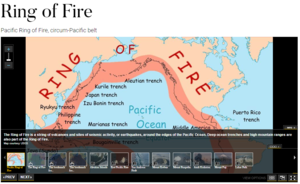Learning Path
Physical Geography Learning Path
By Aoife McDonnell
Resources provided by subject editor, Tara Fitsharris. Resources include physical geography revision notes and recommended national geographic videos on earthquakes, volcanoes, tsunami, impact of dam removal and yellowstone national park volcanic features.
10 resources in this Learning Path
Physical Geography Revision Notes
https://www.scoilnet.ieuploads/resources/18050/17729.pdf Added: 22 Jul 2016 Contributor: Tara Fitzharris Resource type: Guide/notesShort bullet pointed notes for some of the main essay questions asked in the leaving certificate exam about the Physical Geography section of the paper
View full descriptionHow it maps to the curriculum
- SC
- Geography
Strand: C1: Physical Environment
Suggestions for use: This could be used in class as a visual aid when discussing the physical geography section or as an aid to students to help them to construct their own essays on the topic
Earthquake 101- a quick overview
http://video.nationalgeographic.com...-101?cs=related&source=relatedvideo Added: 24 Aug 2016 Contributor: Tara Fitzharris Resource type: Audio / VideoA 2.56 minute video clip created by National Geographic giving an overview of earthquakes, how they form, where they are located and the destruction that they cause. It also examines tsunamis and footage from Nepal 2015.
View full descriptionHow it maps to the curriculum
- SC
- Geography
Strand: C1: Physical Environment
Strand unit: Tectonic
Suggestions for use: This could be used as a visual aid to guide revision of the topic in class with students. It could be first played without sound and ask student to narrate and then as a recap with sound.
Volcanoes 101- a quick overview
http://video.nationalgeographic.com/video/101-videos/volcanoes-101 Added: 24 Aug 2016 Contributor: Tara Fitzharris Resource type: Audio / VideoA 2.28 minute video clip created by National Geographic giving an overview of volcanoes, how they form, where they are located and the different shapes they can develop into.
View full descriptionHow it maps to the curriculum
- SC
- Geography
Strand: C1: Physical Environment
Strand unit: Tectonic
Suggestions for use: This could be used as a visual aid to guide revision of the topic in class with students. It could be first played without sound and ask student to narrate and then as a recap with sound.
Tsunami 101- a quick overview
http://video.nationalgeographic.com/video/101-videos/tsunami-101 Added: 24 Aug 2016 Contributor: Tara Fitzharris Resource type: Audio / VideoA 2.42 minute video clip created by National Geographic giving an overview of tsunamis, how they form, where they are located and the destruction that they cause.
View full descriptionHow it maps to the curriculum
- SC
- Geography
Strand: C1: Physical Environment
Strand unit: Tectonic
Suggestions for use: This could be used as a visual aid to help illustrate the topic in class.
Nepal Earthquake 101- an overview
http://video.nationalgeographic.com...-earthquake-101?source=relatedvideo Added: 25 Aug 2016 Contributor: Tara Fitzharris Resource type: Audio / VideoA 1.49 minute video clip created by National Geographic giving an overview of the Nepal Earthquake 2015. It examines the causes and effects that this earthquake had on the region.
View full descriptionHow it maps to the curriculum
- SC
- Geography
Strand: C1: Physical Environment
Strand unit: Tectonic
Suggestions for use: This could be used as a visual aid to guide revision of the topic in class with students. It could be first played without sound and ask student to narrate and then as a recap with sound.
The impact of dam removal on a river's ecosystem
http://video.nationalgeographic.com...restoration-vin?source=relatedvideo Added: 25 Aug 2016 Contributor: Tara Fitzharris Resource type: Audio / VideoA 3.05 minute video clip created by National Geographic explaining the impact that dam removal on the Elwha River in Washington, USA has had on the river’s ecosystem and salmon population.
View full descriptionHow it maps to the curriculum
- SC
- Geography
Strand: C1: Physical Environment
Strand unit: Rivers
Suggestions for use: This could be used as a visual aid to help illustrate the topic in class.
Yellowstone National Park Volcanic Features
http://video.nationalgeographic.com.../travel-source/yellowstone-overview Added: 01 Sep 2016 Contributor: Tara Fitzharris Resource type: Audio / VideoA 2.54 minute video clip created by National Geographic gives an overview of Yellowstone National Park, USA and its volcanic nature.
View full descriptionHow it maps to the curriculum
- SC
- Geography
Strand: C1: Physical Environment
Strand unit: Tectonic
Suggestions for use: This could be used as a visual aid to help illustrate the topic in class.
Japan Tsunami 2011 Video
http://video.nationalgeographic.com...tsunami-2011-vin?source=searchvideo Added: 01 Sep 2016 Contributor: Tara Fitzharris Resource type: Audio / VideoA 3.34 minute video clip created by National Geographic giving an overview of the Japan tsunami 2011, how it formed, where it was located and the destruction that it caused to the region.
View full descriptionHow it maps to the curriculum
- SC
- Geography
Strand: C1: Physical Environment
Strand unit: Tectonic
Suggestions for use: This could be used as a visual aid to help illustrate the topic in class.
Extracting gas from shale
http://nationalgeographic.org/activity/extracting-gas-shale/ Added: 23 Aug 2016 Contributor: Tara Fitzharris Resource type: Lesson PlanA lesson plan explaining the extracting of natural resources from the ground created by National Geographic. The concept of fracking is also discussed.
View full descriptionHow it maps to the curriculum
- SC
- Geography
Strand: C1: Physical Environment
Strand unit: Rocks / Geology
Suggestions for use: This could be used to pre-teach the concept of human interaction with the rock cycle and the extraction of energy resources from rocks. It also allows teachers to assess the student's levels of prior knowledge of the topic.
Pacific Ring of Fire - National Geographic
http://nationalgeographic.org/encyclopedia/ring-fire/ Added: 05 Jul 2016 Contributor: Tara Fitzharris Resource type: ReferenceA detailed look at the Pacific Ring of Fire and plate boundaries which includes satellite imagery, aerial photographs and links to interactive maps in which various layers can be added
View full descriptionHow it maps to the curriculum
- SC
- Geography
Strand: C1: Physical Environment
Strand unit: Tectonic
Suggestions for use: This resource can be used as a teacher's aid to help students to visualise the information and as an aid to students preparing research projects on the topic


